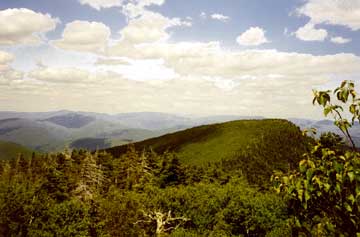Returning to the Catskills: A Sense of Place
I am rooted in the life of the Catskill Mountains. Born and raised in the area, I have a deep appreciation for the natural environment, as well as the rich cultural and community life. At Vassar, my love for the environment and people was further encouraged as I studied religion, music, and education. My thesis project involved working with music students in an afterschool program where we explored group dynamics and our ability to learn. When I joined AmeriCorps, I was thrilled to find myself positioned to help kids consider the history of the Catskills, and offer them a chance to appreciate the unique resources of the area.
In the fall of 2000, AmeriCorps assigned me to work at the Catskill Center for Conservation and Development, a nonprofit organization in Arkville, New York. The center strives to protect the environmental and economic well-being of the Catskill region and its communities. It also educates the youth of the region about their unique environmental and historic heritage. My work involved a curriculum project titled The Catskills: A Sense of Place.
The curriculum — geared toward teaching students in grades four through seven about the water resources, geography, ecosystems, history, and culture of the region — was created using teacher input and brainstorming sessions, staff research, classroom pilots of lesson units, and collaboration with other regional organizations. Besides conducting research for the curriculum, I also co-produced Child of the Mountains — a CD of traditional and contemporary Catskill folk songs, stories, and interviews aimed at enriching students’ exploration of local history.
The Catskills: A Sense of Place is an engaging resource. Students learn, for instance, about the Hudson River School style of painting through analyzing artists’ work and creating their own drawings and paintings based on the land around their hometown and school. They use audio clips from the CD to learn about Catskill industries, New York City reservoirs, and Native Americans from the region. They explore civic government by designing their own community and assessing its strengths and weaknesses.
Since completing this curriculum, I’ve been traveling to schools throughout the six-county region of the Catskills, teaching students about the area. My main goal is to help each student gain an awareness of his or her role as a living piece of the Catskills’ history. Together, we examine aquatic life to learn about biodiversity, watersheds, and the effects of pollutants on the environment. Students conduct interviews to gain insight into their families and community, incorporating family photos into a class album for their school. They study letters, maps, photographs, and brochures to learn about a myriad of topics related to the Catskills. I also lead workshops for teachers, to help familiarize them with the curriculum materials.

The North/South Lake Area is part of the 300,000 acres of the
Catskill Forest Preserve located in southeastern New York.
Besides reconnecting me with the region where I grew up, my work for the Catskills Center for Conservation and Development also led me back to Vassar. In January 2001, I headed for the library to research the life of writer and naturalist John Burroughs. Born in Roxbury, New York, in the heart of the Catskills, Burroughs was influential in shaping people’s perception of, and public policies regarding, the natural environment. He also led numerous outings with Vassar students. The materials I found in Vassar’s Special Collections, particularly the photos, helped fashion a dynamic lesson that explores the life of this prominent Catskills figure.
The Frances Lehman Loeb Art Center, too, was a valuable resource when it came to researching Hudson River School artists. And Vassar Professor of Geography Harvey Flad helped me track down information on the premiere 19th-century landscape architect Andrew Jackson Downing. As has often been the case, I found myself praising the unique resources of our alma mater.
Working on The Catskills: A Sense of Place curriculum has confirmed my belief that it is possible to teach young people using techniques that engage both their minds and imaginations. Effective educators have been using a hands-on, place-based approach to education for years. While this interactive technique inspires wonder and excitement in students, it has, at times, been left by the wayside in attempts to standardize, regiment, and compartmentalize our educational institutions. What the Catskills curriculum reaffirms is that educational goals can be met in an interactive and stimulating fashion: Students learn the facts and figures, but they also learn how to creatively solve problems and explore their world — skills that will serve them, and their communities, for the rest of their lives.

For more information on the Catskill Center and its programs call 845.586.2611, email Anderson at obiabound@hotmail.com, or visit www.catskillcenter.org.
